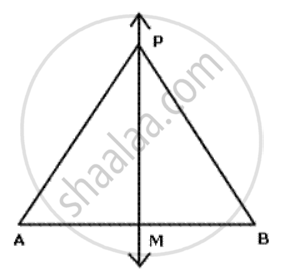Advertisements
Advertisements
Question
Given ∠BAC (Fig), determine the locus of a point which lies in the interior of ∠BAC and equidistant from two lines AB and AC.
Solution
Given: ∠BAC and an interior point P lying in the interior of ∠BAC such that PM = PN.
Construction: Join Ao and produced it to X.
Proof: In right Δs APM and APN we have
PM = PN ...[Given]
AP = AP ...[Common]
So, by RHS criterion of congruence
ΔAPM = ΔAPN
⇒ ∠PAM = ∠PAN ...[∵ Corresponding parts of congruent triangle are equal]
⇒ AP is the bisector of ∠BAC
⇒ P lies on the bisector of ∠BAC
Hence, the locus of P is the bisector of ∠BAc.
Now, we shall show that every point on the bisector of ∠BAC is equidistant from AB and AC.
So, let P be a point on the bisector AX of ∠BAC and PM ⊥ AB and PN ⊥ AC. Then, we have to prove that Pm = PN.
In Δs PAM and PAN, we have
∠PAM = ∠PAN ...[∵ AX is the bisector of ∠A]
∠PMA = ∠PNA ...[Each equal to 90°]
and AP = AP ...[Common]
So, by AAS criterion of congruence
ΔPAM = ΔPAN
⇒ PM = PN ...[∵ Corresponding parts of congruent triangles are equal]
Hence, the locus of point P is the ray AX which is the bisector of ∠BAC.
APPEARS IN
RELATED QUESTIONS
Draw an angle ABC = 75°. Find a point P such that P is at a distance of 2 cm from AB and 1.5 cm from BC.
Construct a triangle ABC, with AB = 6 cm, AC = BC = 9 cm. Find a point 4 cm from A and equidistant from B and C.
AB and CD are two intersecting lines. Find a point equidistant from AB and CD, and also at a distance of 1.8 cm from another given line EF.
A and B are fixed points while Pis a moving point, moving in a way that it is always equidistant from A and B. What is the locus of the path traced out by the pcint P?

In Δ PQR, bisectors of ∠ PQR and ∠ PRQ meet at I. Prove that I is equidistant from the three sides of the triangle , and PI bisects ∠ QPR .
Using only ruler and compasses, construct a triangle ABC 1 with AB = 5 cm, BC = 3.5 cm and AC= 4 cm. Mark a point P, which is equidistant from AB, BC and also from Band C. Measure the length of PB.
Without using set squares or protractor construct a triangle ABC in which AB = 4 cm, BC = 5 cm and ∠ABC = 120°.
(i) Locate the point P such that ∠BAp = 90° and BP = CP.
(ii) Measure the length of BP.
State and draw the locus of a swimmer maintaining the same distance from a lighthouse.
Without using set squares or protractor construct:
(i) Triangle ABC, in which AB = 5.5 cm, BC = 3.2 cm and CA = 4.8 cm.
(ii) Draw the locus of a point which moves so that it is always 2.5 cm from B.
(iii) Draw the locus of a point which moves so that it is equidistant from the sides BC and CA.
(iv) Mark the point of intersection of the loci with the letter P and measure PC.
Without using set squares or protractor.
(i) Construct a ΔABC, given BC = 4 cm, angle B = 75° and CA = 6 cm.
(ii) Find the point P such that PB = PC and P is equidistant from the side BC and BA. Measure AP.
